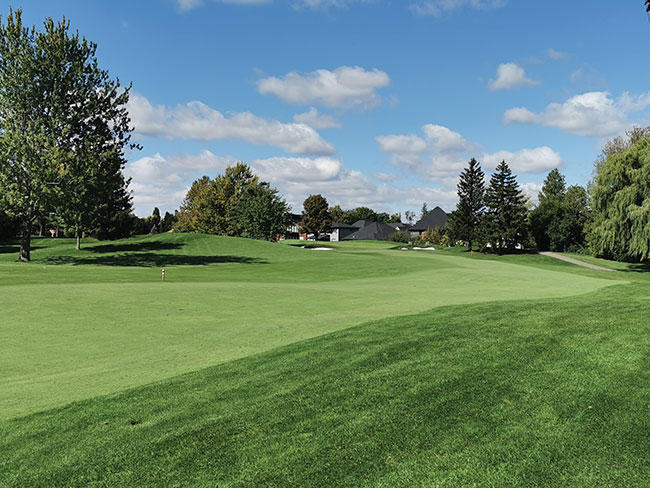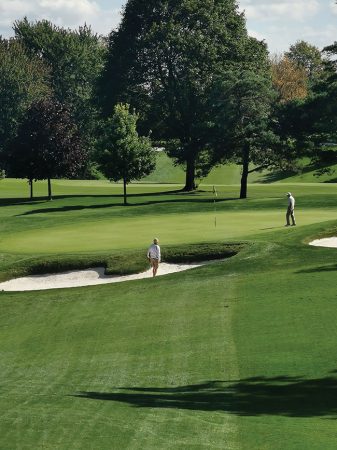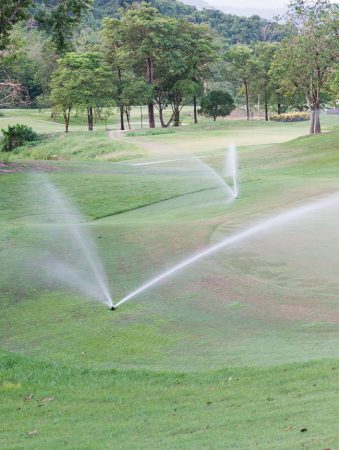
Features
Golf Course Readiness
The evolution of golf course management through the years
Management strategies have evolved over time
February 28, 2022 By Pat Differ

Sometimes, observations made after a passing of time are the most meaningful. The wonders of today may not be the wonders of tomorrow. Golf course management strategies over time have evolved. Greenskeepers became superintendents. Science was always involved.
When soil became sand, the importance of understanding science evolved and emerged as well. This was around the 1970s, and superintendents everywhere learned that sand and soil were much different.
Alternative methods of feeding the plants on our greens became an exploration of sorts. Liquids – solubles mostly from some form of agriculture – emerged in turf. In agriculture, where they had been used for decades, these products, for the most part, were always aimed at the soil. Some were granular and were dissolved, then sprayed in large volumes of water per acre to minimize the “burn” potential. “Will it burn?” was a common question.
The truth is some would absolutely burn, and I still bear the scars of learning that the hard way. Mostly it was because I did not understand the raw materials or the mode of action. Many raw materials were fine for soil applications – more or less going into the ocean of exchange sites. The ability of soil to “buffer” such products offered some protection.
No longer do we sit back as superintendents and be “taught” this direction, as we have all learned about the importance of quality, as specific products were developed for foliar applications on turf. We became educated, and there was a thirst for this information which the brave wanted badly. Snake oils at first slowly became accepted.
It is our responsibility as superintendents to be informed and correct in our decisions on this matter. We are nutrient technicians and specialists. What’s the stress? OK, here’s what will help. Issue-based management – knowing ahead of time heat is on the way – or tournament preparations requires this input.
When this began, it was new. It is no longer new, and those who sell complication are doing so for-profit motive. Growing grass is not going to the moon. The grass knows what to do, which will be mentioned later. We just need to help the plant complete its biological objective, which is the production of mature proteins in our golf environment.
Brave superintendents always experiment, and to do so is almost our duty. We find a better way. I speak of a system that is all encompassing, including soil and the plant’s external and internal chemistries. There is balance.
Base nutrition for regular turfgrass is supplied through root zone absorption chemistry using granulars. Elite turfgrass is achieved by using supplemental internal plant chemistry components – just like an IV in your arm – allowing the plant stomata, to absorb these specialty combinations of organic acids, amino acids, and bio-stimulants, which assist the plant in reaching its biological objective for the next 10-12 days. These supplements provide turgor, inner plant strength and a wear tolerance by propping up plant functions.

Superintendents are adapting to change and are using science and chemistry to their advantage while being environmentally responsible.
Evolution of golf
Golf evolved as well, and superintendents became challenged with demands, including faster greens and smoother surfaces. When the construction boom happened, golf became more manufactured and root zones of sand needed a different standard of care.
It was a perfect storm, really, with the demographic of boomers looking to retire and stay active. The lifestyle of golf was born in golf communities, and retirement communities sprang up all over. Construction boomed. Today, we know things to be much different.
Golf course maintenance also evolved with many new things entering the picture. Speciality equipment emerged, mowing heights were lowered, and speed was where it was at. Televised golf offered the chance to see the manicured grounds of high-end courses all over the world. Little did superintendents know they were thrust into an environment which would force them to learn.
Balancing all of these facts with the emerging science of plant management challenged superintendents to be better and to learn about soil and plant science. We must “own” this knowledge as it is an insurance policy for us. It is a system of learning based on plant chemistry understanding. Plants eat, sleep, have a day shift, and a night shift recovering.
Much of what we learned came from conferences and seminars – where we looked at university research into all aspects of grass management, learning how to elicit a response out of a plant we had always just maintained by setting the spreader on “F” and going. This was fine in soil. It was beginning to become evident to me at the time that I could actually make a living at growing grass and not just cutting it. Sand root zones meant I had to change and learn.
This was a troubling cycle of feeding the plant and treating disease that would result. Literally, pounds of nitrogen per 1,000 square feet were applied in a manner which led to that result. This was plant maintenance and not plant management. Most of us were doing this. We were not “guilty” of doing this but were rather still in the learning mode (those of us who opened our eyes and were not afraid to learn new ways).
The guilt was in not trying to learn this new system that was driven by science. Today, it is my view that with what we have learned by experience, by doing our own testing and by knowing more about the grass plants we work with, we are at a time where a closer look at the definition of nutrition is necessary. It is more than just nutrient. It is organic acids and amino acids which link to produce those mature proteins, plant catalysts and plant defence components of the energy Krebs Cycle. We have these tools.
Fast forward now to 2022. It’s time to retool again, to think, to challenge ourselves in a different time, and to understand how much we have learned over 30 years or so. Science once again plays a leading part where we now know that plants “know” what to do. They have always known what to do.
The sand green, for certain, is part of our lives and has benefits, no doubt. The ensuing plant stress from low mowing and speed demands, really, are self-inflicted wounds. We live on the edge. How much of anything does that plant need? The answer is always…It depends.
We have been forced to go deep. Examine how a plant grows, and not take recommendations for multiple product tank mixes, as has become standard over the last three decades. This is in part because we were all learning these new ways at first. Sales theology needs to be separated from scientific facts.
Doing more with less
Formulation chemistry has also evolved and become more specific. This is a good thing at a good time for superintendents in today’s world. This is a world of tight budgets and doing more with less. Squeeze that nickel. Superintendents are where the buck stops. They have learned to manage their own destiny by choosing the combinations and the timing of applications according to the internal – and always running – clock in their heads. It is elite turfgrass management, with no time for programs in a can anymore. “Turf nutritionists” are in reality salesmen. You are the turf nutritionist.
Yet as superintendents, our “never compromise” attitudes demand that we always maintain that high level of care and high standards of elite turfgrass integrity. This is our job.
Bear with me in this journey. Think.
Think about plants. Think about plants that turn towards the sun in search of energy. Think about our perception of plants. Some, we grow to eat and some, animals eat. Regions of the earth produce specific and amazing kinds of plants. All make their own food, all harvest the sun and adapt to their surroundings. It’s the order of nature. We must adhere to that order, understand it and use it to our advantage. It applies to turfgrass.
Superintendents grow in time windows around such high levels of created stress as low mowing, which immediately upsets the internal plant chemistry and balance. Add shade, traffic, golf conditions, weather, and there you have it – our challenge. There is a balance of club tournament scheduling versus necessary maintenance decisions for a living surface. Our greens are how we are judged, but this, of course, applies to all areas of intensely managed turfgrass – golf and sports fields alike.
Our target is often an eighth of an inch or less in golf or a bit longer on sport fields. Anything foliar must sit on the leaf to have a chance to be absorbed. How much do we really need to put on for that next window? We must balance that with root zone applications of granular where there is a massive feeding structure – roots, or “plant brains.”
Plants are much more sophisticated in sensing than animals. Just to provide an example of this, every single root apex is able to detect and to monitor concurrently and continuously at least 15 different chemical and physical parameters. We tend to underestimate plants and their absolute ability to know what to do.
We watch nature shows and see David Attenborough. He is a wonderful admirer of nature and does great work. He has made some wonderful specials about plant behaviour. When he speaks about plants, everything is correct. When he speaks about animals, it is as if plants do not exist.
The blue whale is the biggest creature that exists on the planet. That is completely wrong. The blue whale is a magnificent creature, but it is dwarfed by the magnificent giant sequoia. This is a living creature that has a mass of 2,000 tons.
Plants are very sophisticated creatures, and that brings us to the meaning of this session. The fact about what we must recognize and learn – that is, on our golf greens today – we need not any longer be using the kitchen sink mentality when considering that very short growth window. “You want me to put how many things in the tank?”
It is our job, our challenge today, to understand the plant from a 2021 perspective, to use what we know to be facts of internal plant chemistry.

Plants, eat, drink, sleep and recover during a 24-hour cycle.
Photo credit: Kwanchaichaiudom/Adobe Stock.
Plants “think” and support themselves
Plants move, and not only toward the sun. Take the Venus fly trap, for example, and watch it snap on a fly. It’s clear evidence that plants think and support themselves if they have what they need. Most of what they need they get from nature. What we do to them in a golf turfgrass environment is to upset that balance in nature, and we need to recognize that.
Really, do we need five, six, seven or eight things in a tank to hit a target that small to last for seven to 10 days? I think not, when we understand the internal workings of the plant. This plant is eating every day through a root system that is massive, and we do need to complement that base feeding with necessary components which allow the plant to complete energy functions or immune system defence in the internal chemistry of the plant at times.
Plants, eat, drink, sleep and recover during the 24-hour cycle. There is a day shift where most stresses occur, and a night shift where most recovery happens.
Plants communicate in an extraordinary manner. They are able to distinguish between kin and non-kin. They communicate with animals by producing chemical volatiles, for example, during pollination. This is a very serious time for plants. They offer a sweet substance to pollinators – serious business – energizing substance for transportation of the pollen.
Charles Darwin, well known for his evolution theory, also did much work on the “power of movement in plants.” He wrote, “it’s hardly an exaggeration to say that the tip of the radical acts like the brain of one of the lower animals.”
The study of the root apex of a rye plant shows movement the same as a worm or snake and every animal that is legless. This movement takes a coordinated effort. The “transition zone” in this root apex consumes the highest level of oxygen in the plant and, more importantly, you have these signals which create the movement – the same as what we have in our brains, which are used to exchange information.
“We know through study that this root apex has just a few hundred cells that show this kind of feature, but we now know how big the root apparatus of a small plant like a rye plant is… it has almost 14 million roots and root hairs,” Stephano Mancuso, a professor of plant neurobiology at the University of Florence, has said. “We have 11-and-a-half-million root apex sections, and a total length of 600 or more kilometres of very highly active surface areas.”
This is a network not unlike the internet or the human nervous system, and all in a plant.
The point I’m making is that as we have evolved through this roughly three-decade journey of foliar nutrient plant management, the law of “a little bit” applies.
I believe we’ve come to a time in plant management chemistry where we have reached the next level of understanding. Label rates for most sophisticated products today are for standalone applications. Formulations have evolved to now reduce into one jug what used to be in three jugs. When two or perhaps three of these are mixed together, a lower rate of individual product is, for sure, the best option. This dramatically reduces the cost of a plan while providing even more nutrition and plant impulse components to the grass plant. Be in charge of your own surfaces.
As always, when forced to learn, some will have reached a dropping-off point. Some say they don’t want to change what they’re doing out of a fear of trying something new. Superintendents, in a way, are like explorers, always wondering “what’s over there” in a kind of search for something better.
This is where we are again – how best to use this knowledge, to do our duty as professional growers in our industry.
It has always been about balance. We now know that to create that balance, we, too, must adapt to change and to use science and chemistry to our advantage if we are to be environmentally responsible and correct as turf managers and to continue this constant of learning.
Pat Differ is general manager at JCL Ag Services in Abbotsford, B.C
Print this page